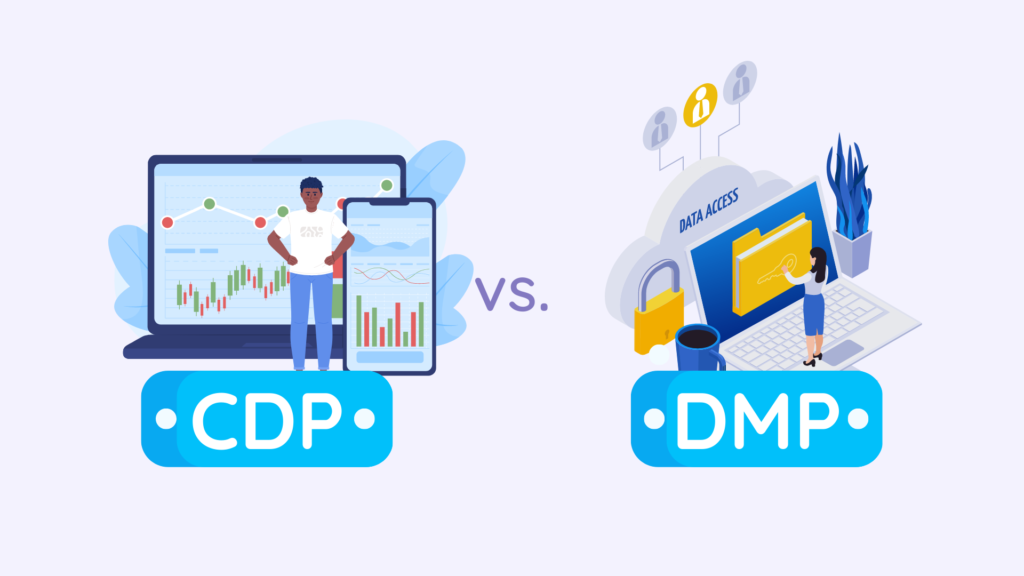Exploring CDPs and DMPs: Understanding Their Roles in Digital Marketing
Customer Data Platforms (CDPs) and Data Management Platforms (DMPs) are two key technologies that, while similar in some respects, fulfill distinct roles in data-driven marketing.
Key Takeaways
- CDPs and DMPs are essential tools in digital marketing that help businesses leverage data for more targeted marketing.
- CDP focuses on first-party data gathered directly from the customers to create comprehensive, persistent customer profiles.
- DMPs primarily use third-party data to segment audiences for broader advertising purposes.
- Integration and compliance with data protection laws are crucial for both platforms.
- The choice between a CDP and a DMP depends on the specific marketing goals and data strategies of a business.
What are CDPs and DMPs?
Customer Data Platforms (CDPs)
A CDP is a software that collects, stores, and manages customer’s first-party data from various sources into a single, comprehensive customer profile. This data includes interactions from web activities, emails, customer service engagements, and more. The primary goal of a CDP is to provide a unified, persistent database accessible by other systems.
Data Management Platforms (DMPs)
Contrarily, a DMP collects and manages data primarily from third-party sources like cookies, ad networks, and mobile apps. It mainly anonymizes and segments this data to target advertising to broader audiences. DMPs focus on short-term data retention as the data is often used for immediate campaign needs and then discarded.
Comparing CDPs and DMPs
| Feature | CDP | DMP |
|---|---|---|
| Data Source | First-party (direct from customers) | Third-party (ads, cookies) |
| Data Type | Identifiable personal info | Anonymized data |
| Usage | Long-term customer engagement | Short-term ad campaigns |
| Integration | Integrates with CRM, marketing tools | Used by advertisers, publishers |
This table highlights the fundamental differences in how these platforms handle data and their primary uses.
Understanding the Role of First-Party and Third-Party Data
First-Party Data
First-party data is collected directly from your interactions with customers. This data is crucial for personalization and building long-term customer relationships. CDPs excel in handling this type of data.
Third-Party Data
Third-party data is sourced from external entities not directly interacting with your business, like advertising networks. DMPs use this type of data to understand broader market trends and to reach new potential customers.
Significance of Data Compliance and Privacy
In the era of GDPR and CCPA, how data is handled is more important than ever. Both CDPs and DMPs must ensure they are compliant with these laws. CDPs, dealing with personal data, need robust security measures. DMPs, while mostly handling anonymized data, also require strict compliance to avoid potential data breaches.
Applications in Marketing
CDP Applications
- Personalized Marketing: Utilizing detailed customer profiles to tailor marketing messages.
- Customer Retention: Analyzing customer behavior to improve satisfaction and retention.
DMP Applications
- Audience Expansion: Finding new customers based on existing segments.
- Ad Targeting Efficiency: Improving the ROI of ad campaigns through precise targeting.
Choosing Between a CDP and a DMP
Deciding whether to implement a CDP or a DMP depends on your marketing objectives:
- Use a CDP if: you aim to deepen customer relationships through personalized engagement.
- Use a DMP if: your focus is on maximizing reach and efficiency in advertising campaigns.
Conclusion
Both CDPs and DMPs offer significant advantages in a data-driven marketing strategy, but they cater to different needs. Understanding these differences is crucial in choosing the right platform for your business goals, ensuring not only compliance with data protection laws but also the effectiveness of your marketing campaigns.

























Leave a Reply